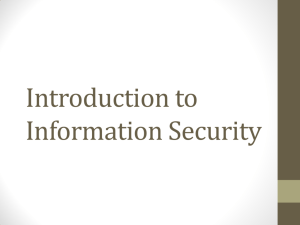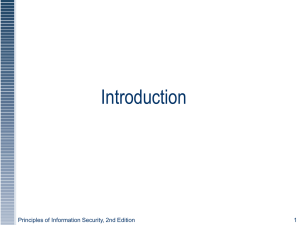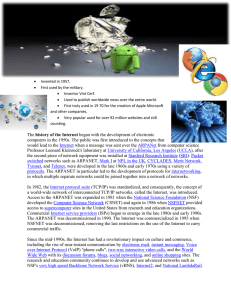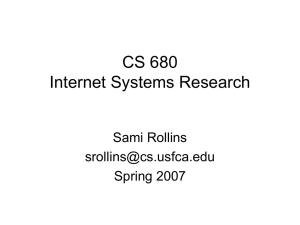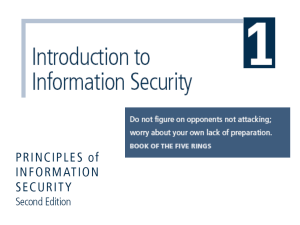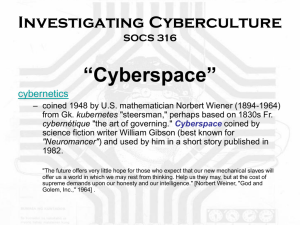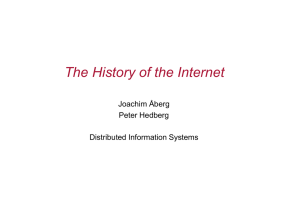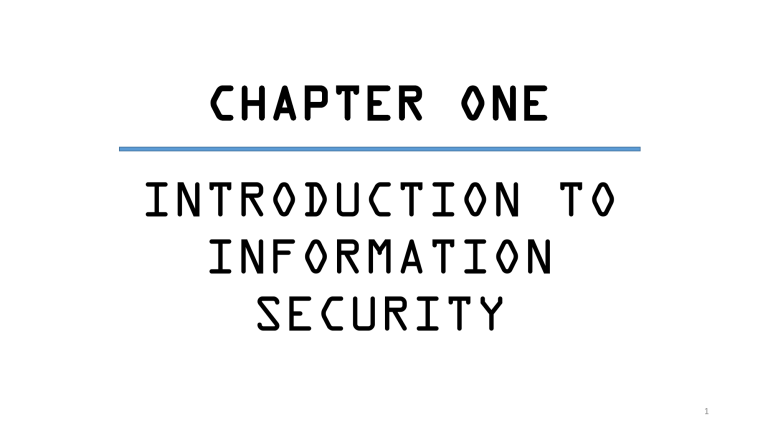
CHAPTER ONE INTRODUCTION TO INFORMATION SECURITY 1 Objectives of today’s class What is security What is information security Critical concepts of Information Security The History of Information Security Security Attacks, Services and Mechanisms 2 What is Security? • Security : is the quality or state of being secure to be free from danger. • Physical security : Product the Physical item, object or areas from unauthorized access and misuse. • Operations security : Protection of the details of particular operation or activities. …continued • Communications security: Protection of organizations communication media, technology and content. • Network security: Protection of Networking Components, connections and contents. • Information security: Protection of Information and its Critical elements What is Information Security? • Information security: a “well-informed sense of assurance that the information risks and controls are inbalance.” • The protection of information and its critical elements, including systems and hardware that use, store, and transmit that information • Necessary tools: policy, awareness, training, education, technology • The NSTISSC (National Security Telecommunications and Information Systems Security Committee) model of information security is known as the C.I.A. triangle (Confidentiality, Integrity, and Availability) – these are characteristics that describe the utility/value of information. C.I.A. triangle now expanded into list of critical characteristics of information • Confidentiality, integrity and availability, also known as the CIA triad, is a model designed to guide policies for information security within an organization. • The model is also sometimes referred to as the AIC triad (availability, integrity and confidentiality) to avoid confusion with the Central Intelligence Agency. • The elements of the triad are considered the three most crucial components of security. Critical concepts of Information Security The value of information comes from the characteristics it possesses: Confidentiality Authentication Integrity Non repudiation Access control Availability …continued • Confidentiality: Ensures that the information in a computer system and transmitted information are accessible only for reading by authorized parties. • Authentication: Ensures that the origin of a message or electronic document is correctly identified, with an assurance that the identity is not false. • Integrity: Ensures that only authorized parties are able to modify computer system assets and transmitted information. Modification includes writing, changing status, deleting, creating and delaying or replaying of transmitted messages. …continued • Non-repudiation: Requires that neither the sender nor the receiver of a message be able to deny the transmission. • Access control: Requires that access to information resources may be controlled by the target system. • Availability: Requires that computer system assets be available to authorized parties when needed. The History of Information Security • Began immediately after the first mainframes were developed. • Groups developing code-breaking computations during World War II created the first modern computers. • Physical controls to limit access to sensitive military locations to authorized personnel. • Rudimentary in defending against physical theft, espionage, and sabotage. The 1960s Advanced Research Projects Agency (ARPA) began to examine feasibility of redundant networked communications. Larry Roberts developed ARPANET from its inception. ARPANET – (Advanced Research Projects Agency Network) ARPAnet began development in 1966 by the United States ARPA. ARPANET was a Wide Area Network linking many Universities and research centers, was first to use packet switching. It was the beginning of what we consider the Internet today. ARPANET was created to make it easier for people to access computers, improve computer equipment, and to have a more effective communication method for the military. The 1970s and 80s • ARPANET grew in popularity as did its potential for misuse. • Fundamental problems with ARPANET security were identified No safety procedures for dial-up connections to ARPANET Non-existent user identification and authorization to system • Late 1970s: microprocessor expanded computing capabilities and security threats. R-609 • Information security began with Rand Report R-609 (paper that started the study of computer security) • Rand Report R-609 was the first widely recognized published document to identify the role of management and policy issues in computer security. • Scope of computer security grew from physical security to include: • Safety of data • Limiting unauthorized access to data • Involvement of personnel from multiple levels of an organization The 1990s • Networks of computers became more common; so too did the need to interconnect networks. • Internet became first manifestation of a global network of networks. • In early Internet deployments, security was treated as a low priority. The Present • The Internet brings millions of computer networks into communication with each other—many of them unsecured. • Ability to secure a computer’s data influenced by the security of every computer to which it is connected. Security Attacks, Services and Mechanisms To assess the security needs of an organization effectively, the manager responsible for security needs some systematic way of defining the requirements for security and characterization of approaches to satisfy those requirements. One approach is to consider three aspects of information security: …continued Security attack – Any action that compromises the security of information owned by an organization. Security mechanism – A mechanism that is designed to detect, prevent or recover from a security attack. Security service – A service that enhances the security of the data processing systems and the information transfers of an organization. The services are intended to counter security attacks and they make use of one or more security mechanisms to provide the service. End of today’s class! 18
